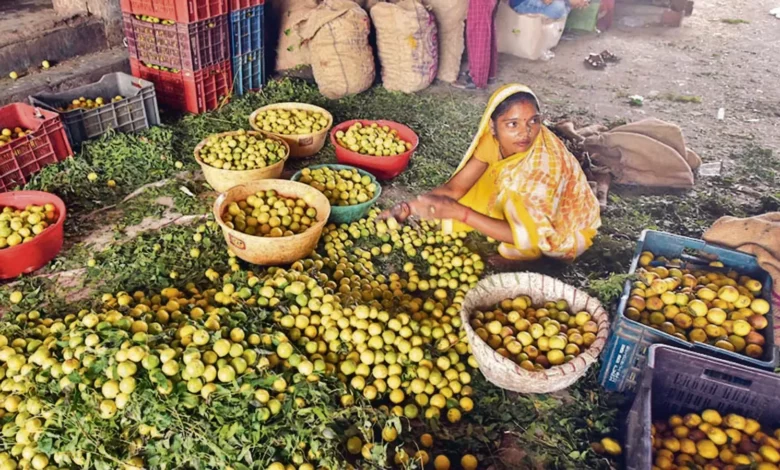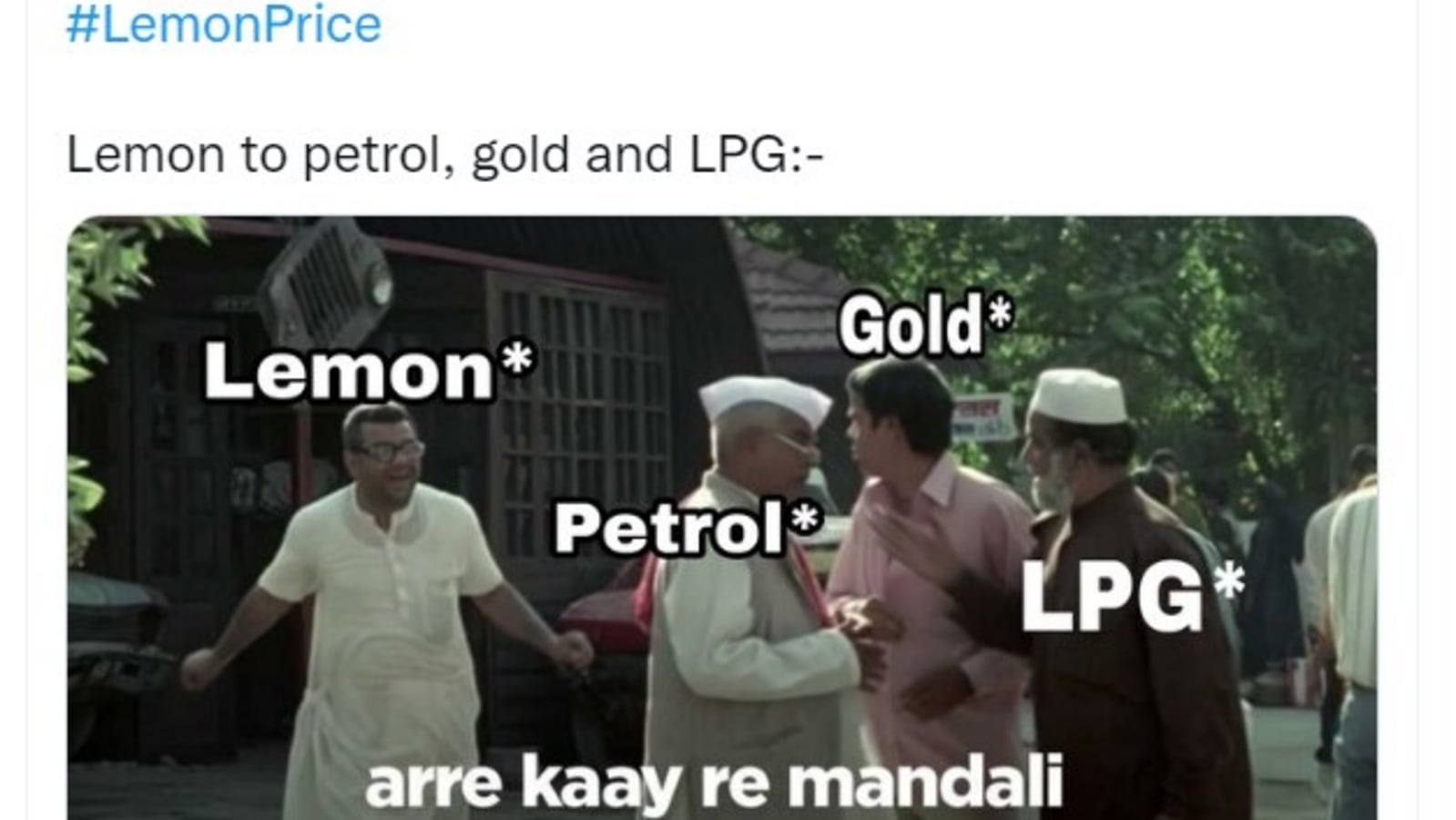When life gives you lemons, make lemonade – Not applicable in India, lemons are 350 INR per kg.

When life gives you lemons, make lemonade – Not applicable in India, lemons are 350 INR per kg.
Due to increased transportation costs resulting from the fuel price spike, vegetable prices have risen across the country, putting customers and sellers in a bind. Depending on its size, a single lemon costs between Rs 18 and Rs 25. Lemons currently sell for roughly Rs 230 per kilo in the wholesale market, with retail rates reaching Rs 400 per kg in many locations.
Vegetable merchants believe that they are experiencing declining profitability and sales due to increased transportation costs and, ultimately, a rise in the purchase price, forcing them to offer vegetables at a higher price, resulting in either a low margin or limited sales.
Lemon, which was selling for Rs 70 per kilogramme until a month ago, has risen to Rs 400 per kilogramme. That is to say; lemon is now three times the price of petrol-diesel. People are increasingly purchasing lemons by the piece rather than by the kilogramme.
There is also Navratri at this time and the month of Ramadan. During fasting and fasting, lemon is also used more. Demand is strong, and production is low. This is one of the causes behind the increase in the price of lemons. The cost of freight has risen in lockstep with gasoline and fuel.
The price of all fruits and vegetables, including lemon, has risen. Soft drinks, as well as numerous medicinal and culinary products, contain lemon. Lemons are being sent directly from the farms to the manufacturers. Lemon is also not reaching the market due to this, even though it is high demand.
Why Is the Price of Lemons Increasing?

- Lower Yield: The states of Andhra Pradesh, Gujarat, Maharashtra, and Telangana supply most of the country’s lemons. Sudden rains have wreaked havoc on the crops in several areas. A shortage of citrus fruit has resulted as a result of this.
- Fasting during the festivals of Navratri and Ramadan increases the intake of lemons. In India, the price of lemons has also risen due to this.
- Fuel Price Increase: India’s rising fuel and diesel prices have resulted in a 15% increase in transportation costs.
- This has impacted the price of lemons and the price of other fruits and vegetables.
- Soft Drink Industry: A significant portion of the lemon harvested in the country is sent directly to soft drink factories. As a result, the markets do not receive enough supplies to meet demand, increasing costs.
Prices of Lemon at different places around India
The price of lemon in Rajasthan has soared to new heights.
The most expensive cities are Jodhpur and Jaipur, with costs ranging from Rs 350 to Rs 400 per kilogramme. In Chittorgarh, 240 lemons are sold per kilogramme, but in Kota, 250 lemons are sold per kilogramme.
Lemon prices have risen dramatically not only at retail but also at wholesale. In March, the wholesale price of lemon in Jaipur was Rs 60 per kg, but by April, it had risen to Rs 300 per kg, up from Rs 250 in March. Similarly, the wholesale price in Jodhpur increased from Rs 60 to Rs 320. The cost of a lemon has shattered all previous records. Unseasonal rains have wreaked havoc on the lemon crop in various parts of the country, including Madras, Maharashtra, and Gujarat. Because output has fallen short of demand, prices have soared to new heights.
In Odisha, lemons are being sold for Rs 10 apiece.
Is it ten rupees for a lemon slice? Yes, you read that correctly. At Cuttack’s largest wholesale and retail vegetable mandi, Chhatrabazar, a single piece of lemon now costs Rs 10. The price of a single lemon has dropped from Rs 20 for four lemons a few days ago to Rs 10 for a single unit, creating considerable difficulty for the average man.
Lemon demand often rises in the summer. To beat the summer heat in Odisha, many individuals prefer a glass of lemonade. Apart from that, it is one of the necessities that complements the indigenous cuisine of ‘Pakhala.’ Similarly, lemon is utilised to give curry and other liquids a tangy flavour.
“I had never heard that a lemon costs Rs ten.” For a piece of lemon, we paid a maximum of Rs 2.50. Compared to other retail marketplaces in the city, the pricing of all veggies at Chhatrabazar is usually low. “However, vendors are selling lemons at Rs 10 per piece here,” a client explained.
Customers have objected to the outrageous increase in lemon prices, even though state agricultural minister Arun Sahoo told the State Assembly last month that Odisha is India’s most significant producer of lemon and mushroom.
In Morabadi, Lalpur, and Kutchery, the price of a lemon has more than doubled.
The demand for lemon, a famous fruit high in vitamin C and acts as a fantastic source of summer coolant, spikes during the summer. Most homes choose nimbu-paani (lemon juice or water) after meals or otherwise since it aids digestion and soothes frayed nerves. Lemon prices have doubled in retail markets in Ranchi, putting a strain on household budgets as temperatures continue to rise in the capital and across the state, with some areas experiencing heatwave conditions. In just a few days, the price of a lemon has doubled at some famous retail vegetable marts in Morabadi, Lalpur, and Kutchery.
In Morabadi, a medium-sized lemon was sold for Rs 10 per piece on Monday. Similar circumstances existed in Lalpur, where large lemons were priced between Rs 12 and Rs 15 per piece, causing some buyers to become irritated due to growing inflation.
Customers in Rajkot have been struck by exorbitant lemon pricing.
Rajkot (Gujarat), April 2 (ANI): Rajkot (Gujarat) is a city in Gujarat. Lemon prices have risen dramatically in Rajkot, Gujarat. Lemons were previously sold for Rs 50-60 per kilo.”The cost of a kilogramme of lemon is approaching Rs 200.” Once, it was roughly Rs 50-60/kg. Our ‘kitchen budget’ is affected as a result.’ “I’m not sure when the rates will go down,” a consumer stated on April 2.
In Satellite, a lemon costs between Rs 18 and Rs 25 depending on its size. Lemons sell for roughly Rs 230 per kilo in the wholesale market, but retail rates in Satellite, Jodhpur, and Vastrapur reach Rs 400 per kg.
“The blazing heat, Chaitra Navratri, and the holy month of Ramzan have led to a rise in demand, and prices have jumped from Rs 130 a kilogramme last week to Rs 230 presently,” said Deepak Patel, secretary of the Jamalpur Agricultural Produce Market Committee.
Lemon production in Gujarat and South India has also been hampered by unseasonal rain and unfavourable weather. “Lemons from Bhavnagar and Rajkot, Gujarat’s two key lemon-growing regions, are in short supply,” he said.
In Delhi-NCR, it is being offered for an unbelievable price of Rs 300/kg.
What is genuinely burning a hole in customers’ purses among the growing prices of veggies is the expense of lemon. It is being sold at an astonishing price of Rs 300/kg in Delhi-NCR. Due to soaring costs, even if you give up your plan to buy half a kilogramme or 250 grams of lemon and expect to get one piece, it will not be inexpensive. These days, a lemon costs Rs ten.
Citrus fruits, consumed regularly by practically all households, have become out of reach for the average person.
It’s not just the lemons that have become overpriced; vegetables have grown overpriced. Green veggies are becoming increasingly difficult in the city and surrounding areas since their costs have skyrocketed.
A single lemon costing Rs 10 in Hyderabad as well
With the onset of the summer season, lemon prices have risen dramatically in the last week, with a single lemon costing Rs 10 in Hyderabad city. Lemon vendors expressed alarm over the citrus fruit’s escalating price, alleging that buyers are unwilling to pay such a high price for the citrus fruit. “The cost of living has skyrocketed. We used to get a complete lemon sack for Rs 700, but today they cost Rs 3,500. Nobody wants to buy a single lemon that we’re offering for Rs 10. Nobody wants to accept that the prices have increased, therefore they leave without buying lemons “According to Venkatesh, a roadside vendor.
According to Gultekdi, a wholesale market in Pune, lemon arrivals have plummeted by 60%.
EXTREME HEAT is not just bad for wheat, but it’s also bad for lemons. High temperatures have caused the market-ready crop to get charred in several lemon-growing zones, driving up prices.
For the next two months, the current trend is projected to continue. In Pune’s wholesale market, a single lemon costs Rs 5, and by the time it reaches the retail market, it costs between Rs 10 and Rs 12 apiece.
Lemons from Maharashtra are supplied to Madhya Pradesh, Delhi, and Rajasthan in addition to home markets, but this year’s crop is insufficient to go elsewhere.
The state with the most farmers is Andhra Pradesh, followed by Maharashtra, Gujarat, Tamil Nadu, and Odisha. The arrival of lemon has decreased by 60%, according to Vilas Bhujbal, a commission agent at Pune’s wholesale market at Gultekdi.
As a result of the increase in fuel prices in Haridwar, vegetables and fruits have become more expensive in Uttarakhand.
Vegetables and fruits have gotten more expensive in Uttarakhand due to the increase in fuel prices in Haridwar. “Almost all veggies have increased in price; lemon sells for Rs 200-250 per kg in the mandi, while gourd sells for Rs 30-35 per kg,” claimed a vegetable vendor.
Due to Vietnamese imports, the price of lemons in Bangladesh has decreased.
In recent weeks, lemon prices have risen across Bangladesh due to a lack of supply and increasing demand in the run-up to Ramadan. However, on Monday, April 3, it was reported that Vietnamese lemons were once again available on the market. Significant price deflation for lemon has come from a famous exporter’s sudden supply of lemon.
The scarcity of the beloved lemon fruit increased after oversized shipments of Vietnamese lemons arrived in the Maldives with an unprecedented delay. Lemon shipments were initially scheduled for March 30. However, they arrived on the 31st and were not cleared from the commercial harbour for the next two days due to both Friday and Saturday being public holidays.
According to significant sellers and wholesalers, lemon prices have dropped noticeably in local markets.
Conclusion
What do we do with this price hike in everything? How do we survive in this kind of world where lemons are costlier than apples and oranges? Where did the time go when vendors used to give green chillies and coriander leaves free of cost to the customers?
According to local mandis vendors, the price of vegetables rises typically throughout the summer season. However, several other variables are causing the price of lemons to increase right now. The primary cause is the rise in gasoline and diesel prices. The cost of transportation has increased due to the increase in gasoline prices, as have the prices of vegetables.
Meanwhile, agricultural scientists claim that unseasonal rains and weather changes have harmed the production of lemons. Because of the increasing demand for lemons during the summer, prices have risen, and availability has remained limited.
Not only are lemons hurting the middle class, but ginger, which is primarily used in tea during the pandemic, is being sold for Rs 80-100 per kg. Ladyfingers, beans, and other legumes are also available at Rs 120 per kg.
Not only are homes concerned, but vegetable dealers are as well. Their sales have decreased because of the high price increase, and revenues have declined. They are compelled to offer veggies at higher prices, resulting in limited sales each day and a narrow profit margin.
According to a few sellers, tomato costs have also risen from Rs 25 to Rs 40 per kilogramme. Market analysts say that the increase in vegetable costs is due to the rise in fuel prices, such as gasoline, diesel, and compressed natural gas (CNG).
In the last several days, gasoline and diesel prices have risen dramatically. As most vehicles and lorries use these fuels, this has increased the cost of vegetables and lemons. CNG prices have been raised by Rs 7 per kilogramme in the last three to four days and are presently hovering at Rs 70 per kilogramme, a record high.






